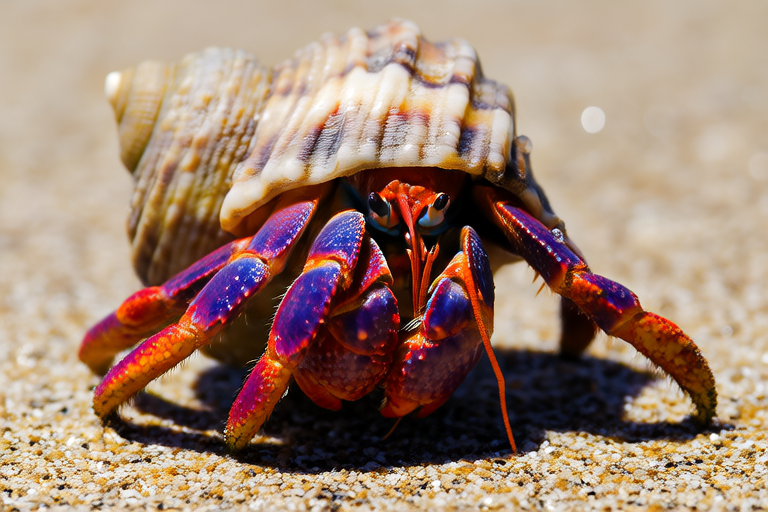Uncovering the Hidden World of Hermit Crabs: Everything You Need to Know
Hermit crabs are fascinating creatures that have captured the hearts of many pet enthusiasts. These small crustaceans are known for their unique lifestyle and their ability to adapt to various environments. In this comprehensive guide, we will delve into the world of hermit crabs, exploring their biology, habitat preferences, dietary needs, molting process, shell-changing behaviors, common health issues, suitable tank setups for captivity, interaction with humans, myths versus facts, and tips for responsible ownership.
Biology of Hermit Crabs
Hermit crabs belong to the superfamily Paguroidea and are characterized by their soft, unprotected abdomens. Unlike other crabs, they cannot create their own shells; instead, they inhabit discarded mollusk shells. This adaptation allows them to protect their vulnerable bodies while still being mobile. Hermit crabs come in various species, with Coenobita clypeatus (the Caribbean hermit crab) and Coenobita compressus (the Ecuadorian hermit crab) being popular choices for pet owners.
Habitat Preferences
In their natural environment, hermit crabs can be found in tropical and subtropical regions near coastal areas. They thrive in humid conditions and often live in colonies on beaches, mangroves, and coral reefs. When kept as pets, it’s essential to replicate these conditions to ensure their well-being. A well-maintained habitat with proper humidity levels and temperature control is crucial for the health and happiness of your hermit crabs.
Dietary Needs
Hermit crabs are omnivorous scavengers, meaning they eat both plant and animal matter. Their diet in the wild consists of algae, decaying plant material, and small marine animals. As pets, they require a balanced diet that includes a variety of foods such as fruits, vegetables, and protein sources like fish flakes or boiled eggs. It’s important to avoid feeding them processed human food, as it may contain harmful additives.
Molting Process
The molting process is a critical part of a hermit crab’s life cycle. During molting, the crab sheds its exoskeleton to allow for growth. Before molting, hermit crabs often become less active and may burrow into substrate. Owners should provide a hiding spot filled with moist substrate to help facilitate this process. Molting can take several weeks, during which the crab is extremely vulnerable. It’s essential to handle the crab gently and avoid disturbing it during this time.
Shell Changing Behaviors
One of the most intriguing aspects of hermit crab behavior is their shell-changing habits. As hermit crabs grow, they need larger shells to accommodate their expanding bodies. In the wild, they compete for suitable shells, sometimes even fighting over them. In captivity, providing a variety of shells of different sizes ensures that each crab has the opportunity to find a comfortable home. It’s important to regularly check the condition of the shells and replace any that are damaged or too small.
Common Health Issues
Hermit crabs can suffer from various health problems if their living conditions are not optimal. Common issues include dehydration, respiratory distress, and shell rot. To prevent these issues, maintain a consistent humidity level and ensure that the substrate remains moist but not waterlogged. Regularly inspect your crabs for signs of illness, such as lethargy, discoloration, or difficulty breathing. If you notice any concerning symptoms, consult a veterinarian who specializes in exotic pets.
Suitable Tank Setups for Captivity
Creating a suitable tank setup is crucial for the well-being of your hermit crabs. The tank should be spacious enough to allow for movement and exploration. A general rule of thumb is to provide at least 10 gallons of space per crab. The substrate should be deep enough to allow for burrowing, typically around 3-4 inches. Use a mixture of sand, coconut fiber, and moss to mimic their natural environment. Additionally, include various climbing structures, hiding spots, and a shallow water dish for soaking.
Interaction with Humans
Hermit crabs can develop strong bonds with their owners, especially when handled gently and consistently. While they may not respond to commands like dogs or cats, they can learn to recognize familiar faces and enjoy gentle interactions. Handling your hermit crabs regularly helps them become more comfortable with human contact, making it easier to perform routine maintenance tasks.
Myths Versus Facts
There are many misconceptions about hermit crabs that can lead to improper care. One common myth is that hermit crabs are low-maintenance pets. In reality, they require careful attention to their environmental needs and a varied diet. Another misconception is that hermit crabs don’t need companionship. While they can live alone, they often benefit from the company of other hermit crabs, as they are social creatures in the wild.
Tips for Responsible Ownership
Owning hermit crabs responsibly involves understanding their needs and providing appropriate care. Here are some tips to ensure your hermit crabs live happy and healthy lives:
- Provide a suitable tank setup with proper substrate, humidity, and temperature control.
- Offer a varied diet that includes fresh fruits, vegetables, and protein sources.
- Regularly clean the tank to prevent the buildup of harmful bacteria.
- Monitor your crabs for signs of illness and seek veterinary care when necessary.
- Handle your crabs gently and provide opportunities for social interaction.
By following these guidelines, you can create a nurturing environment for your hermit crabs and enjoy the rewarding experience of owning these unique and fascinating creatures.
Hermit crabs are more than just pets; they are ambassadors of the ocean’s hidden world. By understanding their biology, habitat preferences, dietary needs, molting process, shell-changing behaviors, common health issues, suitable tank setups for captivity, interaction with humans, myths versus facts, and tips for responsible ownership, you can provide the best possible care for your hermit crabs and ensure their well-being. With proper care and attention, hermit crabs can make wonderful companions for many years to come.
